For Breakages
& Emergencies
What to do in the event of:

DISCOMFORT
General discomfort from your braces.

IRRITATION
Irritation of Mouth, Lips, Gums or Cheeks

Mouth Ulcers
Do You Have Discomfort From Braces?

SHARP & POKEY WIRE
How To Fix a Sharp & Pokey Wire
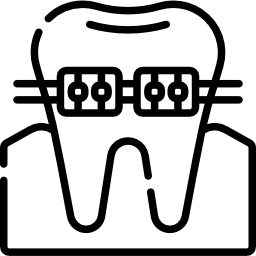
LIGATURE & MODULES
Lost or Loose Ligature or Modules?
Why do braces & wires break?
Braces can break due to a mouth injury or eating the wrong type of foods like hard or sticky substances, which can cause the wire to break or become loose. Sometimes brushing your teeth too vigorously, flossing very hard or using toothpicks can also cause breakages.
The first step is not to panic – broken braces are quite a common scenario people face everyday, however some action should be taken to get your broken braces fixed as damaged braces may cause discomfort, abrasions and if left unattended, can affect your Orthodontic treatment results. We recommend you give us a call so we can help determine the best course of action. If there is discomfort and your appointment is a while away, you may also choose to do some minor adjustments yourself to alleviate the pain before you get to your next Orthodontic appointment. If in doubt or are unsure, please leave your braces as is and give us a call on (07) 5573 6535.

Discomfort
It is normal for people to have discomfort for a day or two after getting their braces put on or after an Orthodontic adjustment. Sometimes appliance adjustments can also make eating uncomfortable. Rest assured though that the discomfort is both normal and temporary. To make things easier we recommend soft foods, rinse your mouth with warm salt water and in some circumstances just some over-the-counter pain relievers.
Braces On
General discomfort can be experienced 1-5 days after having braces fitted or starting Invisalign treatment. It may be difficult to bite down, check out our Orthodontic Friendly Soft Foods Recipes Book for ideas.
Stubborn Food Stuck Between Teeth
Although not an emergency, having large chunks of food stuck between your braces and teeth everyday can become annoying and uncomfortable. This can be easily fixed with a piece of dental floss (Super floss) or by using an interproximal brush (Piksters) to dislodge any food.
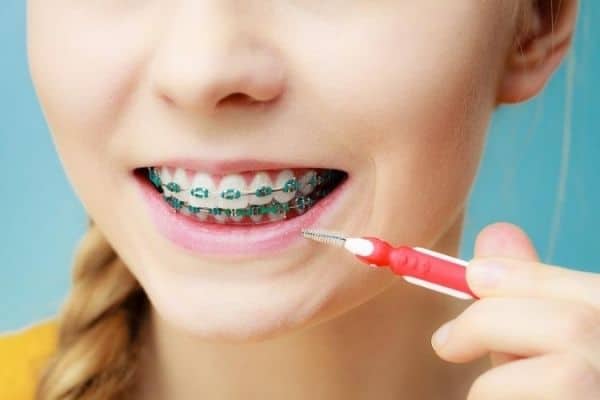

Irritation of Lips, Gums or Cheeks
Sometimes getting new braces cause irritation in the mouth, lips, gums or cheeks – especially when eating, but rest assured these are only temporary. Other times throughout treatment (especially after an adjustment), you may encounter irritation also, the cause of this may be from a protruding wire or appliances and can be fixed by the following home remedies below. As always, if you have a major concern, please call our Orthodontic team on (07) 5573 6535.
• Using Orthodontic Wax
The unique properties of Orthodontic/dental wax can help alleviate pain by protecting your gums from the metal edges of braces. Orthodontic wax is solid at room temperature but can be softened and shaped by the warmth of your hands. When rubbed onto the braces that cause irritation, it sticks to the rough edges and creates a buffer between the brackets and the gums. Orthodontic wax remains smooth while in your mouth and harmlessly flakes or peels away as it breaks down. You can wear the wax overnight and replace as needed, though you should replace it every two days. While you can eat and drink with wax, you should remove it if food gets stuck or the wax gets dirty.
Available in-clinic or at your local chemist.
How To Put On Orthodontic Wax On Braces
Whether you’re protecting your gums from new braces or sticking down a piece of protruding wire, please follow the following steps when applying Orthodontic wax
✔️ Wash your hands
✔️ Brush all of your teeth
✔️ Pinch off a piece of wax about the size of a pea
✔️ Squeeze the wax until it softens and roll it until a ball, then flatten the ball slightly
✔️ Gently push the wax into the problem area of the braces. You might find it helpful to use your tongue to adjust the wax
To remove, you can gently and diligently use an interdental stick or floss, but do take care not to damage your braces or gums. Also keep in mind if the wire continues to protrude or gets out of place, please contact us so we can adjust it for you.
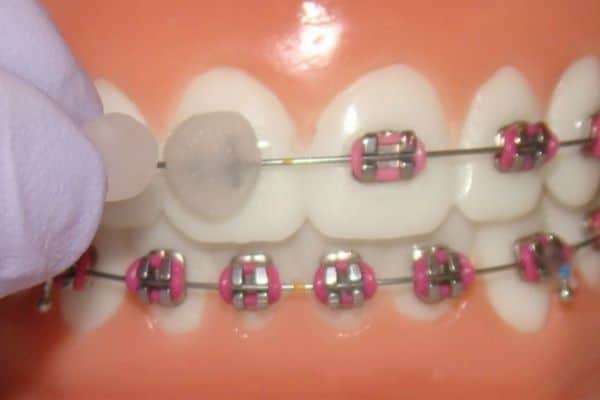
• Utilising a Pencil Eraser
Sometimes you will have a thinner wire in your mouth that is poking out and causing discomfort. If this is the case, and wax does not seem to do the trick, you may use the eraser end of a pencil to gently bend the wire back into a more comfortable shape for your mouth. Make sure to use a pencil with a clean eraser. Pull your cheek away from the area and gently use the eraser to push the wire closer to your teeth and under or behind the archwire if at all possible. This method may or may not work on the archwire itself, but can help with thinner wires. A pencil eraser can also be used to push in the ligature wires on your brackets (where the bands go) that are causing lip or gum irritation.
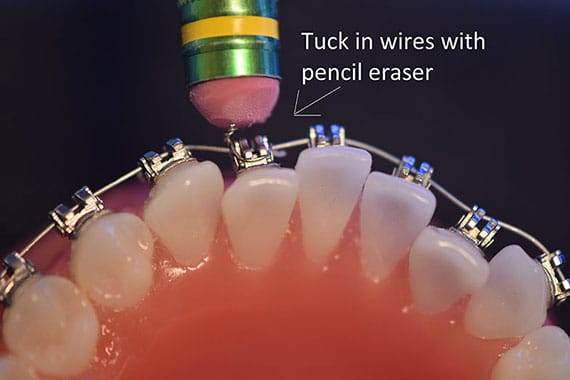
• Using Tweezers
We do recommend you contact your Orthodontist beforehand for best advice. Otherwise you can use tweezers to re-insert archwires that have slipped out of the molar bracket. This can happen on the back teeth and can be fixed with sterile tweezers. (You may have to have an adult help you with this). Make sure the tweezers are clean and sterile before using them as you will be putting them in your mouth. Grab the end of the wire with the tweezers and carefully insert it back into the bracket slot. After the wire is securely back in the bracket slot, you can use wax to keep the wire in place until your next orthodontic appointment. If you are unsure, please do not attempt and give your Orthodontist a call to inform them of the situation. Tweezers can also be used to bend a ligature wire back into place if it is poking out (much like how you can use a pencil rubber). If a ligature rubber band comes loose, tweezers can be used to place the band around the bracket once more.
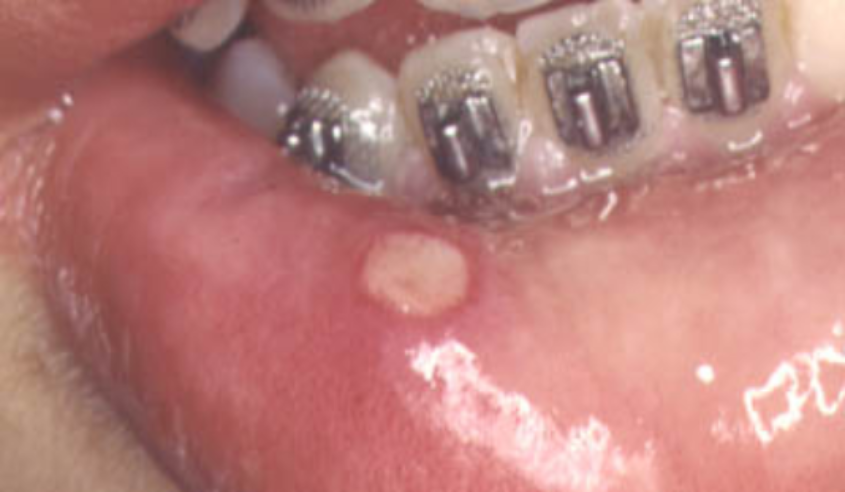
Mouth Ulcers
Some patients are susceptible to episodes of mouth ulcers which may be precipitated or exacerbated by an irritation from braces. One or several areaes of ulceration of the cheeks, lips or tongue may appear. This is not an emergency, but may be uncomfortable temporarily. Prompt relief may be achieved by applying a small amount of wax to the braces directly opposing the ulcers (See Orthodontic Wax). A topical anaesthetic (such as brace relief) may be applied directly to the ulcerated surface, you can also get some at our clinic. Furthermore regular rinses with warm salt water (2-3 times per day) can also help.
How To Fix a Sharp or Pokey Wire
We know how annoying and uncomfortable sharp and pokey wires can be. Knowing how to handle a sharp wire can put you at ease and give you the relief you need fast. Rest assured it is not uncommon for archwires and ligatures to sometimes poke into your lips and gums, follow the tips below for an immediate home solution when a trip to our clinic is not an immediate option. As always, please feel free to give us a call if you have serious concerns. Sometimes you can’t see your Orthodontist immediately or if its a holiday or weekend, so these helpful home tips might come in handy as a temporarily solution until your next appointment.
✅ Use an Orthodontic wax
✅ Bending a wire with a pencil rubber
✅ Using tweezers


Ligatures Come Off
If a rubber ligature should come off, you may be able to put it back in place using clean/sterile tweezers. If a wire ligature comes loose, simply remove it with sterile tweezers. If the wire ligature is sticking out into the lip but is not loose, it may be bent back down to eliminate the irritation using either sterile tweezers or even the eraser end of a pencil.
Lost Module or Ligature
Tiny rubber bands or small fine wires known as ligatures hold the wire into your bracket. If a rubber or wire ligature is lost rest assured it is not a serious problem, simply call our friendly team to inform them or wait until your next Orthodontic appointment.



